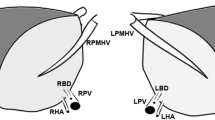Abstract
A cadaver liver is divisible into two transplants by section between right and left lobes, or section between left medial segment and left lateral segment medial to the umbilical cleft. To establish the ideal basis of partition of the portal elements, an anatomic study of 33 livers was performed. It is preferable to section the left portal vein, longer and more constant than the right, the right branch of the hepatic artery, larger and more constant than the left, and the left hepatic duct because of the vascularization of the common hepatic duct. To use the length of the left portal vein, it is necessary to section all its branches to segment I and then to resect this segment. After a section between the left medial segment and the left lateral segment medial to the umbilical cleft, the left medial segment always loses its total portal venous vascularization and should be resected. Before a split-liver, cholangiography and arteriography should be performed to detect anatomical variations without performing an extensive dissection which may endanger the vascularity of the bile ducts.
Résumé
Un foie de cadavre est divisible en deux transplants, par une séparation du foie droit et du foie gauche ou une séparation du lobe droit et du lobe gauche à droite de la scissure ombilicale. L'étude anatomique de 33 foies a permis d'établir les modalités idéales de partage des éléments portaux. Il faut sectionner préférentiellement la veine porte gauche, plus longue et plus constante que la veine porte droite, la branche droit de l'artère hépatique, plus volumineuse et plus constante que sa branche gauche, et le canal hépatique gauche compte tenu de la vascularisation de la voie biliaire principale. Pour utiliser la longueur de la veine porte gauche, il est nécessaire d'interrompre toutes ses branches destinées au segment I et donc de réséquer ce segment. Après une séparation du lobe droit et du lobe gauche à droite de la scissure ombilicale, le segment IV perd constamment la totalité de son apport veineux portal et doit être réséqué. Avant une division hépatique, une cholangiographie et une artériographie doivent être réalisées afin de mettre en évidence d'éventuelles variations anatomiques au cours d'une dissection étendue susceptible d'entrainer une dévascularisation des voies biliaires.
Resumen
Un hígado cadavérico es divisible en dos trasplantes al seccionarlo entre sus lóbulos derecho e izquierdo o al seccionarlo entre el segmento medial izquierdo y el segmento lateral izquierdo medial a la hendidura umbilical. Se realizó un estudio anatómico sobre hígados con el objeto de definir las bases ideales para la partición de los elementos portales. Es preferible seccionar la vena porta izquierda, que es más larga y más constante que la derecha, la rama derecha de la arteria hepática, más voluminosa y más constante que la izquierda, y el canal hepático izquierdo en razón de la vascularización del colédoco. Para poder usar la longitud de la vena porta izquierda es necesario seccionar la totalidad de sus ramas hasta el segmento I y luego resecar este segmento. Después de la sección entre el segmento medial izquierdo y el segmento lateral izquierdo medial a la hendidura umbilical, el segmento medial izquierdo siempre pierde toda su vascularización venosa portal y debe ser resecado. Antes de dividir el hígado se debe realizar colangiografía y arteriografía con el objeto de detectar variaciones anatómicas y evitar disecciones extensas que pueden poner en peligro la vascularización de los canales biliares.
Similar content being viewed by others
References
Bismuth, H., Morino, M., Castaing, D.: Emergency orthotopic liver transplantation in two patients using one donor liver. Br. J. Surg.76:722, 1989
Broelsch, C.E., Emond, J.C., Whitington, P.F., Thistlethwaite, J.R., Baker, A., Lichtor, J.L.: Application of reduced-size liver transplants as split grafts, auxiliary orthotopic grafts, and living related segmental transplants. Ann. Surg.212:368, 1990
Emond, J.C., Whitington, P.F., Thistlethwaite, J.R., Cherqui, D., Alonso, E.A., Woodle, I.S., Vogelbach, P., Busse-Henry, S.M., Zucker, A.R., Broelsch, C.E.: Transplantation of two patients with one liver: Analysis of a preliminary experience with “split liver” grafting. Ann. Surg.212:14, 1990
Otte, J.B., de Ville de Goyet, J., Alberti, D., Balladur, P., de Hemptinne, B.: The concept and the technique of the split liver in clinical transplantation. Surgery107:605, 1990
Pichlmayr, R., Ringe, B., Gubernatis, G., Hauss, J., Bunzendahl, H.: Transplantation of one donor liver to two recipients (splitting transplantation): A new method for further development of segmental liver transplantation. Langenbecks Arch. Surg.373:127, 1988
Shaw, B.W., Wood, R.P., Stratta, R.J., Langnas, A.N., Marujo, W., Grazi, G.L., Saito, S.: Management of arterial anomalies and encountered in split-liver transplantation. Transplant. Proc.22:420, 1990
Couinaud, C.: Le foie: Études anatomiques et chirurgicales. Paris, Masson, 1957, pp. 9–181
Czerniak, A., Lotan, G., Hiss, Y., Shemesh, E., Avigad, I., Wolfstein, I.: The feasibility of in vivo resection of the left lobe of the liver and its use for transplantation. Transplantation48:26, 1989
Couinaud, C.: Anatomie chirurgicale du foie. Quelques aspects nouveaux. Chirurgie112:337, 1986
Foucou, P., Ould Said, H., Joyeux, A.: Le segment I du foie ou lobe de spigel: Etude anatomique et intérêt chirurgical. J. Chir. (Paris)120:179, 1983
Gans, H.: On the anatomy of the liver and its repercussions on surgery: Preliminary report. Arch. Chir. Neerl.2:770, 1955
Northover, J.M.A., Terblanche, J.: A new look at the arterial supply of the bile duct in man and its surgical implications. Br. J. Surg.66:379, 1979
Healey, J.E., Schroy, P.C.: The anatomy of the bile ducts within the human liver: Analysis of the prevailing pattern of branchings and the major variations of the biliary ducts. Arch. Surg.61:599, 1953
Gupta, C.D., Mittal, U.K., Gupta, S.C.: Intrahepatic pattern of the biliary ducts and their major variations. Indian J. Med. Res.63:1130, 1975
Author information
Authors and Affiliations
Rights and permissions
About this article
Cite this article
Rat, P., Paris, P. & Favre, J.P. One liver for two: Partition of the portal elements. World J. Surg. 16, 1167–1170 (1992). https://doi.org/10.1007/BF02067091
Issue Date:
DOI: https://doi.org/10.1007/BF02067091




